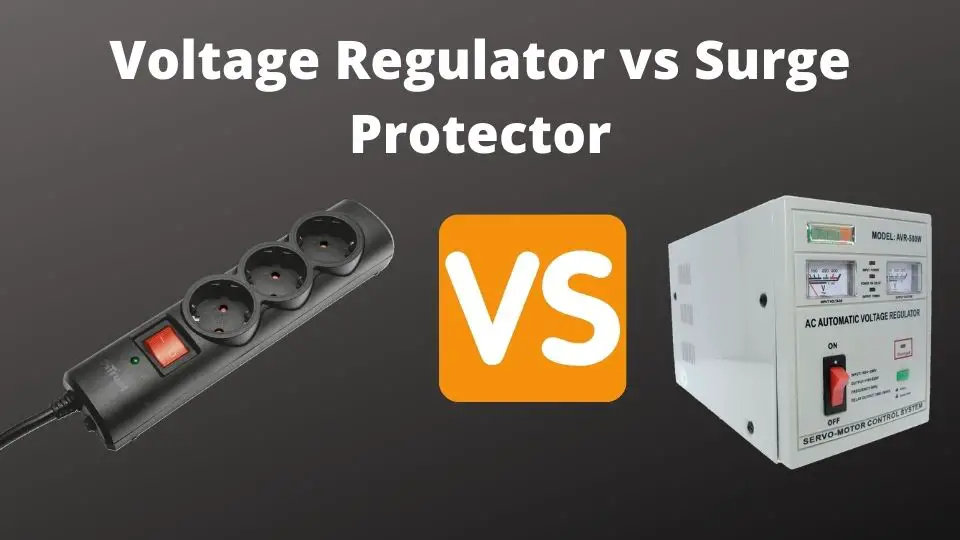This post may contain affiliate links. As an affiliate, we earn from qualifying purchases. We get commissions for purchases made through links in this post.
Do you know the difference between a voltage regulator and a surge protector? A voltage regulator is designed to maintain a constant voltage level, while a surge protector is designed to protect your electrical devices from spikes. This is the main difference between the surge protector and voltage regulator which should already give you some idea of which one you should use.
Having said that, voltage regulator and surge protector needs to be chosen wisely depending on your needs. Protecting your electrical devices and power equipment is a complex topic and you will need to know some more details about how the voltage regulator differs from the surge protector.
What is the Surge Protector?
A surge protector is a device that is used to protect electrical devices from voltage spikes. The main job of the surge protector is to absorb the excess voltage and dissipate it as heat. This will help to protect your electronic devices from being damaged by exceeding voltage levels.
It usually comes in a form of a power strip that contains an additional electrical component called a metal oxide varistor, which is responsible for absorbing the excess voltage. You can plug your appliances into the surge protector as if it was a standard power strip, but, you will gain more benefits from having your devices protected from power surges.
There is also a whole-house surge protector that can be installed by an electrician. This will protect your entire home from voltage spikes. It costs more than a portable surge protector and requires a qualified professional to perform its installation.

A surge protector can degrade in time. In case of frequent electricity spikes, the surge protection components will wear off quickly, therefore reducing the efficiency of a surge protector.
What is the Voltage Regulator?
The voltage regulator is a device that is used to maintain a constant voltage level. It will help to ensure that your devices are always running at the same voltage, regardless of the fluctuations of your power source such as a power generator or a residential electric power distribution. This is important for devices that need a stable voltage in order to function properly.
In contrast to a surge protector, an AVR (automatic voltage regulator) allows for a fine-tuning of your desired output voltage. An automatic voltage regulator does not wear off with time, allowing you to use the same device for many years without losing its efficiency.
An automatic voltage regulator is based on a transformer that allows increasing or decreasing the output voltage to match it with your desired levels (usually 110V or 220V).
An AVR protects your devices from electric spikes and brownouts. Most modern voltage regulators utilize CPUs and algorithms that automatically step down or step up the output voltage depending on the input electricity.
The downside of a voltage regulator is a higher cost and not many power outlets, so you will have to use a power strip in between your appliances and an AVR.
Same as the surge protector, the automatic voltage regulator is available both as a portable and a standby type. However, the whole-hose voltage regulator (or a home voltage stabilizer) would cost significantly more. You should carefully consider the necessity of installing such a standby AVR. In most cases, you would be just fine using an AVR for most valuable devices (such as TVs, fridges, and computers).


What is the difference between the Voltage Regulator and Surge Protector?
The main difference between the voltage regulator and surge protector is that the voltage regulator is designed to maintain a constant voltage level, while the surge protector is designed to protect your electrical devices from voltage spikes.
Another difference between the two is that a voltage regulator allows for a fine-tuning of lower and higher bounds of voltage that flows to your electrical devices, while a surge protector only protects against sudden spikes in voltage.
Additionally, voltage regulators are more durable than surge protectors. Surge protector components can degrade over time depending on how frequently the spike happens, whereas a voltage stabilizer will not lose its protective properties over time.
Should you use a Voltage Regulator or a Surge Protector?
This is a difficult question to answer as it depends on your specific needs. If you need a device that will help to maintain a constant voltage level, then you should use a voltage regulator. However, if you are looking for protection against electrical spikes, then you will be fine just using a surge protector.
Using an automatic voltage regulator instead of a surge protector makes sense in case your power source is very unstable with frequent fluctuations. In case you are using a portable power generator, consider using an inverter one as it already comes with almost no fluctuations and is more power-efficient.
If your home electrical source is stable enough, you can safely use a surge protector for your most expensive electronics or power tools. For most households, a portable surge protector is more than enough.




1 thought on “Voltage Regulator vs Surge Protector”
Comments are closed.